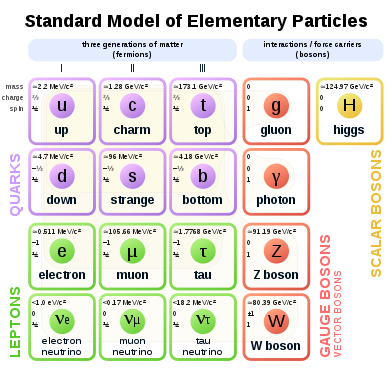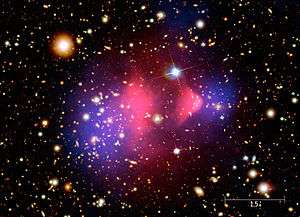Laboratori Nazionali del Gran Sasso
Laboratori Nazionali del Gran Sasso (LNGS) is the largest underground research center in the world. Situated below Gran Sasso mountain in Italy, it is well known for particle physics research by the INFN. In addition to a surface portion of the laboratory, there are extensive underground facilities beneath the mountain. The nearest towns are L'Aquila and Teramo. The facility is located about 120 km from Rome.
_2014-02.jpg) Overview of overground laboratories of LNGS | |
| Established | 1985 |
|---|---|
| Research type | Particle physics, nuclear physics |
| Director | Lucia Votano; Stefano Ragazzi (since October 2012) |
| Location | L'Aquila, Abruzzo, Italy 42.454°N 13.576°E[1] |
Operating agency | INFN |
| Website | www.lngs.infn.it |
The primary mission of the laboratory is to host experiments that require a low background environment in the fields of astroparticle physics and nuclear astrophysics and other disciplines that can profit of its characteristics and of its infrastructures. The LNGS is, like the three other European underground astroparticle laboratories (Laboratoire Souterrain de Modane, Laboratorio subterráneo de Canfranc, and Boulby Underground Laboratory), a member of the coordinating group ILIAS.
Facilities
The laboratory consists of a surface facility, located within the Gran Sasso and Monti della Laga National Park, and extensive underground facilities located next to the 10 km long Traforo del Gran Sasso freeway tunnel.
The first large experiments at LNGS ran in 1989; the facilities were later expanded, and it is now the largest underground laboratory in the world.[2]
There are three main barrel vaulted experimental halls, each approximately 20 m wide, 18 m tall, and 100 m long.[2] These provide roughly 3×20×100=6,000 m2 (65,000 sq ft) of floor space and 3×20×(8+10×π/4)×100=95,100 m3 (3,360,000 cu ft) of volume. Including smaller spaces and various connecting tunnels, the facility totals 17,800 m2 (192,000 sq ft) and 180,000 m3 (6,400,000 cu ft).[3][2]
The experimental halls are covered by about 1400 m of rock, protecting the experiments from cosmic rays. Providing about 3400 metres of water equivalent (mwe) shielding, it is not the deepest underground laboratory, but the fact that it can be driven to without using mine elevators makes it very popular.
Research projects
Neutrino research
Since late August 2006, CERN has directed a beam of muon neutrinos from the CERN SPS accelerator to the Gran Sasso lab, 730 km away, where they are detected by the OPERA and ICARUS detectors, in a study of neutrino oscillations that will improve on the results of the Fermilab to MINOS experiment.
In May 2010, Lucia Votano, Director of the Gran Sasso laboratories, announced that "[t]he OPERA experiment has reached its first goal: the detection of a tau neutrino obtained from the transformation of a muon neutrino, which occurred during the journey from Geneva to the Gran Sasso Laboratory."[4] This finding indicates a deficiency in the Standard Model of particle physics, as neutrinos would have to have mass for this change to occur.
An effort to determine the Majorana/Dirac nature of the neutrino, called CUORE (Cryogenic Underground Observatory for Rare Events), is operating in the laboratory (as of 2018). The detector is shielded with lead recovered from an ancient Roman shipwreck, due to the ancient lead's lower radioactivity than recently minted lead. The artifacts were given to CUORE from the National Archaeological Museum in Cagliari.[5]
In September 2011, Dario Autiero of the OPERA collaboration presented findings that indicated neutrinos were arriving at OPERA about 60 ns earlier than they would if they were travelling at the speed of light. This faster-than-light neutrino anomaly was not immediately explained.[6][7] The results were subsequently investigated and confirmed to be wrong. They were caused by a flawed optic fiber cable in OPERA receiver of the laboratory,[8] resulting in late arrival of the clock signal to which the neutrinos' arrivals were compared.
In 2014 Borexino measured directly, for the first time, the neutrinos from the primary proton-proton fusion process in the Sun. This result is published on Nature. This measurement is consistent with the expectations derived from the standard solar model of J. Bahcall along with the theory of solar neutrino oscillations as described by MSW theory. In 2020 Borexino measured also solar neutrinos originated from CNO cycle, a fusion process common in giant stars but uncommon in the Sun (only 1% of Sun's energy output).[9] With this outcome Borexino has unraveled both the two processes powering the Sun and many main sequence stars.
Experiments
See also
References
- Colosimo, Gabriele; Crespi, Mattia; Mazzoni, Augusto; Riguzzi, Federica; Jones, Mark; Missiaen, Dominique (14 April 2012), Determination of the CNGS global geodesy (PDF), p. 6, OPERA public note 132 v3
- "INFN Laboratori Nazionali del Gran Sasso Annual Report 2011" (PDF). p. 4. Retrieved 16 August 2015.
- Miramonti, Lino (31 March 2005). "European underground laboratories: An overview". AIP Conference Proceedings. 785: 3–11. arXiv:hep-ex/0503054. Bibcode:2005AIPC..785....3M. doi:10.1063/1.2060447.
- Particle Chameleon Caught in the act of Changing, Press Release, CERN, 31 May 2010, accessed 22 November 2016.
- Roman ingots to shield particle detector, Nature, 15 April 2010.
- Particles break light-speed limit, Nature, 22 September 2011.
- Adam, T.; et al. (OPERA Collaboration) (2012). "Measurement of the neutrino velocity with the OPERA detector in the CNGS beam". Journal of High Energy Physics. 2012 (10): 93. arXiv:1109.4897. Bibcode:2012JHEP...10..093A. doi:10.1007/JHEP10(2012)093.
- Neutrinos sent from CERN to Gran Sasso respect the cosmic speed limit, 8 June 2012.
- First detection of solar neutrinos from the CNO cycle with Borexino, Indico-FNAL, , 23 June 2020.
External links
| Wikimedia Commons has media related to Laboratori Nazionali del Gran Sasso. |


